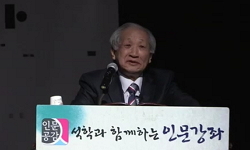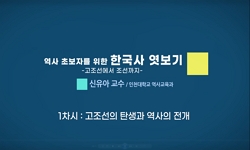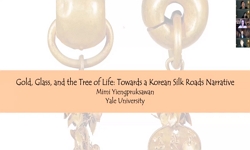Although the existence of Cheonjusa Temple (or Naejeseokgung), a royal temple of the Silla dynasty, has been identified based on a fragmentary record, no detailed research on the temple has been conducted to date. This study aims to examine historical...
http://chineseinput.net/에서 pinyin(병음)방식으로 중국어를 변환할 수 있습니다.
변환된 중국어를 복사하여 사용하시면 됩니다.
- 中文 을 입력하시려면 zhongwen을 입력하시고 space를누르시면됩니다.
- 北京 을 입력하시려면 beijing을 입력하시고 space를 누르시면 됩니다.

고고자료를 통해 본 신라 천주사(내제석궁)의위치와 성격 = A Study on the Location and Characteristics ofSilla’s Cheonjusa Temple (Naejeseokgung) based on Archeological Materials
한글로보기https://www.riss.kr/link?id=A108629137
-
저자
양은경 (부산대학교)
- 발행기관
- 학술지명
- 권호사항
-
발행연도
2023
-
작성언어
Korean
-
주제어
신라 ; 통일신라 ; 천주사 ; 동궁과 월지 ; 월성 ; 제석 ; Silla ; Unified Silla ; Cheonjusa temple ; Donggung Palace and Wolji Pond ; Wolseong Palace(Moon Palace)
-
등재정보
KCI등재
-
자료형태
학술저널
-
수록면
5-32(28쪽)
- 제공처
-
0
상세조회 -
0
다운로드
부가정보
다국어 초록 (Multilingual Abstract)
First, based on an examination of various ancient relics including roof tiles and stone objects, it is assumed that Cheonjusa Temple was located due west of Donggung Palace and Wolji Pond, both of which were located outside Wolseong Palace. Judging by the overall shape and manufacturing technique of the convex roof-end tile bearing the inscription “Cheonju, it is presumed to have been produced sometime between the late Silla period and the early Goryeo period. In addition, a concave roof-tile with lotus design, which was discovered at the former site of Cheonjusa Temple, has been dated to the late sixth or early seventh century, which corresponds to the record stating that Cheonjusa Temple was founded during the reign of King Jinpyeong of Silla (r. 579-632).
Second, a comprehensive examination of the results of the excavation of Donggung Palace and Wolji Pond, and of the records of Samguk yusa (Memorabilia of the Three Kingdoms), suggests that Cheonjusa Temple was located to the northwest of Jeongjeonji (Building Site A). In addition, the Naewontap Pagoda, which is mentioned in Samguk yusa, Volume 5 “Wolmyeongsa Dosolgajo (Song of Dosol or Maitreva Buddha by Buddhist monk Wolmyeongsa),” is estimated to have been located to the northwest of Jeongjeonji (Building Site A in the west) at the site of Donggung Palace and Wolji Pond. Furthermore, it is assumed that Cheonjusa Temple was a formal Buddhist temple with a wooden pagoda, inhabited by Buddhist monks, where Buddhist ceremonies were held on a regular basis.
Third, it is assumed that the temple was named “(Nae)Jeseokgung” because Jeseok, i.e., King Sakra or Indra, was worshiped there. However, its other name, Cheonju, is believed to have originated from a traditional faith whose followers revered the god of heaven (cheonju) in Korea. Based on references to the kingdom of Baekje’s Jeseoksa Temple and its royal palace in Iksan, the distance between Naejeseokgung (Cheonjusa Temple) and Wolseong Palace has been proven, and Cheonjusa Temple is now believed to have been a formal Buddhist temple where Buddhist events and ceremonies were regularly held.
Although the existence of Cheonjusa Temple (or Naejeseokgung), a royal temple of the Silla dynasty, has been identified based on a fragmentary record, no detailed research on the temple has been conducted to date. This study aims to examine historical evidence, such as relics bearing the inscription “Cheonju” and other relevant artifacts, in order to ascertain the location of Silla’s royal palace, and to briefly examine the connection between the temple and the Buddhist practices of the royal house during the Silla Dynasty based on the name of the temple.
First, based on an examination of various ancient relics including roof tiles and stone objects, it is assumed that Cheonjusa Temple was located due west of Donggung Palace and Wolji Pond, both of which were located outside Wolseong Palace. Judging by the overall shape and manufacturing technique of the convex roof-end tile bearing the inscription “Cheonju, it is presumed to have been produced sometime between the late Silla period and the early Goryeo period. In addition, a concave roof-tile with lotus design, which was discovered at the former site of Cheonjusa Temple, has been dated to the late sixth or early seventh century, which corresponds to the record stating that Cheonjusa Temple was founded during the reign of King Jinpyeong of Silla (r. 579-632).
Second, a comprehensive examination of the results of the excavation of Donggung Palace and Wolji Pond, and of the records of Samguk yusa (Memorabilia of the Three Kingdoms), suggests that Cheonjusa Temple was located to the northwest of Jeongjeonji (Building Site A). In addition, the Naewontap Pagoda, which is mentioned in Samguk yusa, Volume 5 “Wolmyeongsa Dosolgajo (Song of Dosol or Maitreva Buddha by Buddhist monk Wolmyeongsa),” is estimated to have been located to the northwest of Jeongjeonji (Building Site A in the west) at the site of Donggung Palace and Wolji Pond. Furthermore, it is assumed that Cheonjusa Temple was a formal Buddhist temple with a wooden pagoda, inhabited by Buddhist monks, where Buddhist ceremonies were held on a regular basis.
Third, it is assumed that the temple was named “(Nae)Jeseokgung” because Jeseok, i.e., King Sakra or Indra, was worshiped there. However, its other name, Cheonju, is believed to have originated from a traditional faith whose followers revered the god of heaven (cheonju) in Korea. Based on references to the kingdom of Baekje’s Jeseoksa Temple and its royal palace in Iksan, the distance between Naejeseokgung (Cheonjusa Temple) and Wolseong Palace has been proven, and Cheonjusa Temple is now believed to have been a formal Buddhist temple where Buddhist events and ceremonies were regularly held.
국문 초록 (Abstract)
첫째, 기와와 석부재 등 고고유물을 기준으로 살펴 본 결과 천주사의 위치는 월성 외부이자 동궁과 월지 서편에 소재한 것으로 유추하였다. 근거자료로 제시한 천주명 수막새의 제작연대는 전체적인 형태와 제작기법을 기준으로 8세기, 천주명 암키와는 나말여초로 추정하였다. 또한 (전)천주사지 일대에서 수습한 연화문수막새는 6세기 후반~7세기 전반으로 편년되는 이유로 인해 천주사가 진평왕대에 건립되었다는 문헌기록과 서로 부합함을 확인하였다. 둘째, 동궁과 월지 유구의 발굴성과와 三国遺事기록을 종합하여 고찰한 결과 천주사의 위치는 추정 정전지(A건물지)의 서북쪽 일대로 비정하였다. 다시 말해 三国遺事권5 月明師兜率歌条에서 언급한 내원탑은 동궁과 월지의 정전지(서편 A건물지)를 기준으로 서북쪽에 위치한 것으로 추정하였다. 또한 천주사는 목탑을 갖춘 정식 가람으로 승려가 거주하고 불교행사가 거행된 사찰로 해석하였다. 셋째, 천주사의 또 다른 이름이었던 제석궁은 제석을 모신 이유로 인해 사찰이름이 정해진 것으로 여겼으며, 천주사의 天主는 하늘을 경외한 전통신앙과 연결된 것으로 보았다. 또한 신라 왕실에서 강조한 천주사상은 불교신앙의 제석과 결합하여 새롭게 탄생한 우리나라의 특징적인 존재로 보았다. 마지막으로 신라 내제석궁(천주사)과 월성 사이의 거리는 동 시대 백제 제석사와 익산 왕궁의 관계에서 유사한 사례를 찾을 수 있었으며, 역으로 백제의 사례를 근거로 신라 천주사의 위치 추정안을 공고히 하였다.
단편적인 기록이지만 신라는 천주사(내제석궁)로 명명되는 내도량의 존재가 확인됨에도 불구하고 지금까지 구체적인 연구는 활발하게 이루어지지 못하였다. 이에 본고는 “천주”가 표기...
단편적인 기록이지만 신라는 천주사(내제석궁)로 명명되는 내도량의 존재가 확인됨에도 불구하고 지금까지 구체적인 연구는 활발하게 이루어지지 못하였다. 이에 본고는 “천주”가 표기된 유물과 관련 유구를 기준으로 그 소재지를 고증하고자 노력하였으며, 아울러 寺名을 기준으로 신라 왕실불교에 대해서도 간략하게 살펴보았다.
첫째, 기와와 석부재 등 고고유물을 기준으로 살펴 본 결과 천주사의 위치는 월성 외부이자 동궁과 월지 서편에 소재한 것으로 유추하였다. 근거자료로 제시한 천주명 수막새의 제작연대는 전체적인 형태와 제작기법을 기준으로 8세기, 천주명 암키와는 나말여초로 추정하였다. 또한 (전)천주사지 일대에서 수습한 연화문수막새는 6세기 후반~7세기 전반으로 편년되는 이유로 인해 천주사가 진평왕대에 건립되었다는 문헌기록과 서로 부합함을 확인하였다. 둘째, 동궁과 월지 유구의 발굴성과와 三国遺事기록을 종합하여 고찰한 결과 천주사의 위치는 추정 정전지(A건물지)의 서북쪽 일대로 비정하였다. 다시 말해 三国遺事권5 月明師兜率歌条에서 언급한 내원탑은 동궁과 월지의 정전지(서편 A건물지)를 기준으로 서북쪽에 위치한 것으로 추정하였다. 또한 천주사는 목탑을 갖춘 정식 가람으로 승려가 거주하고 불교행사가 거행된 사찰로 해석하였다. 셋째, 천주사의 또 다른 이름이었던 제석궁은 제석을 모신 이유로 인해 사찰이름이 정해진 것으로 여겼으며, 천주사의 天主는 하늘을 경외한 전통신앙과 연결된 것으로 보았다. 또한 신라 왕실에서 강조한 천주사상은 불교신앙의 제석과 결합하여 새롭게 탄생한 우리나라의 특징적인 존재로 보았다. 마지막으로 신라 내제석궁(천주사)과 월성 사이의 거리는 동 시대 백제 제석사와 익산 왕궁의 관계에서 유사한 사례를 찾을 수 있었으며, 역으로 백제의 사례를 근거로 신라 천주사의 위치 추정안을 공고히 하였다.
참고문헌 (Reference)
1 이기백, "한국고대사론" 일조각 1995
2 국립부여문화재연구소, "제석사지 발굴조사보고서 Ⅱ" 2013
3 국립부여문화재연구소, "제석사지 발굴조사보고서 Ⅰ" 2011
4 서영대, "신라의 불교수용과 천신관념" 10 : 1998
5 김유식, "신라기와연구" 민속원 2014
6 박상준, "신라·백제의 왕권강화와 제석신앙" 동국대학교 대학원 2007
7 주보돈, "신라 왕경의 이해" 주류성 2020
8 전덕재, "신라 왕경의 역사" 새문사 2009
9 김동하, "신라 사찰의 분포와 왕경의 형성" 신라문화연구소 57 : 63-92, 2020
10 하근영, "신라 단판능선연화문수막새의 계통과 전개" 한국고고학회 (109) : 256-291, 2018
1 이기백, "한국고대사론" 일조각 1995
2 국립부여문화재연구소, "제석사지 발굴조사보고서 Ⅱ" 2013
3 국립부여문화재연구소, "제석사지 발굴조사보고서 Ⅰ" 2011
4 서영대, "신라의 불교수용과 천신관념" 10 : 1998
5 김유식, "신라기와연구" 민속원 2014
6 박상준, "신라·백제의 왕권강화와 제석신앙" 동국대학교 대학원 2007
7 주보돈, "신라 왕경의 이해" 주류성 2020
8 전덕재, "신라 왕경의 역사" 새문사 2009
9 김동하, "신라 사찰의 분포와 왕경의 형성" 신라문화연구소 57 : 63-92, 2020
10 하근영, "신라 단판능선연화문수막새의 계통과 전개" 한국고고학회 (109) : 256-291, 2018
11 이병호, "백제와 신라 왕실 여성의 崇佛 활동과 尼寺" 백제문화연구소 (65) : 37-60, 2021
12 국립경주박물관, "문자로 본 신라" 2002
13 양은경, "동궁과 월지 출토 불상의 봉안양상과 신라왕궁 속 불교시설" 신라문화연구소 62 : 161-188, 2023
14 김경열, "동궁과 월지 주변 건물군의 구조와기능에 대한 고고학적 검토-월지 서편 A건물지를 중심으로-" 신라사학회 (57) : 161-209, 2023
15 이선희, "고신라 수막새의 편년 검토"
16 안지원, "고려의 국가 불교의례와 문화" 서울대학교 출판부 2005
17 김길식, "고려 개경 서부건축군의 성격과 배치구조의 사상적 배경" 중부고고학회 11 (11): 69-112, 2012
18 국립경주문화재연구소, "경주지역 폐사지 기조조사·연구" 2012
19 차순철, "경주지역 평기와의 타날형태 변화에 대한 검토: 단판,중판,인장 그리고 장판으로" 40 : 2007
20 국립경주문화재연구소, "경주 월성 시·발굴보고서" 2021
21 노윤성, "경주 東宮과 月池-서편 건물지 복원고증연구 및 실시 설계 와전 고증" 경주시·경상북도문화재연구원 2019
22 김경열, "경주 東宮과 月池 유적 건물지 配置 및 空間區劃 검토" 한국고대사학회 (100) : 51-82, 2020
23 "東京雜記"
24 "朝鮮古蹟圖譜"
25 국립경주문화재연구소, "月城垓子" 2012
26 金誠龜, "新羅瓦塼: 아름다운 신라기와, 그 천년의 숨결" 國立慶州博物館 2000
27 국립경주박물관, "新羅瓦塼" 2000
28 윤선태, "新羅王宮과 國家寺刹 - 그 분포와 도로 체계를 중심으로 -" 신라문화연구소 57 : 93-119, 2020
29 신종원, "新羅初期佛敎史硏究" 민족사 1992
30 김영태, "新羅佛敎天神考" 15 : 1978
31 김상현, "新羅三寶의 成立과 그 意義" 14 : 1980
32 김민식, "新羅 寶相華文 수막새의 變遷" 영남대학교 2019
33 "新增東國輿地勝覽"
34 국립경주문화재연구소, "慶州 西部洞 19番地 遺蹟 發掘調査報告書" 2003
35 국립경주문화재연구소, "慶州 東宮과 月池-복원정비사업 발굴조사보고서 A건물지-" 2018
36 "佛說帝釋所問經, 한글대장경 1권"
37 申昌秀, "三國時代 新羅기와의 硏究 —皇龍寺址 出土 新羅기와를 中心으로—" 20 : 1987
38 "三国遺事"
39 경상북도문화재연구원, "『청도 풍각초등학교 다목적 교실 신축부지 내 청도 봉기리 유적』본문·사진" 2006
40 大韓民國文化部文化財管理局, "『雁鴨池』發掘調査報告書-本文編·圖版編" 學生社 1993
41 文化公報部 文化財管理局, "『雁鴨池』發掘調査報告書" 1978
42 국립경주문화재연구소, "『慶州 東宮과 月池』Ⅰ 발굴조사보고서" 2012
동일학술지(권/호) 다른 논문
-
해인사 소장 간경도감 목판의 각수 출신지와 15세기 계수관의 역할- 『四分律刪繁補闕行事紗詳集記』와 『俱舍論頌疏抄』를 중심으로
- 한국중세고고학회
- 신은제
- 2023
- KCI등재
-
조선시대 구들주거의 구조와 변천과정- 평택 고덕국제화계획지구를 중심으로
- 한국중세고고학회
- 김용호
- 2023
- KCI등재




 DBpia
DBpia






